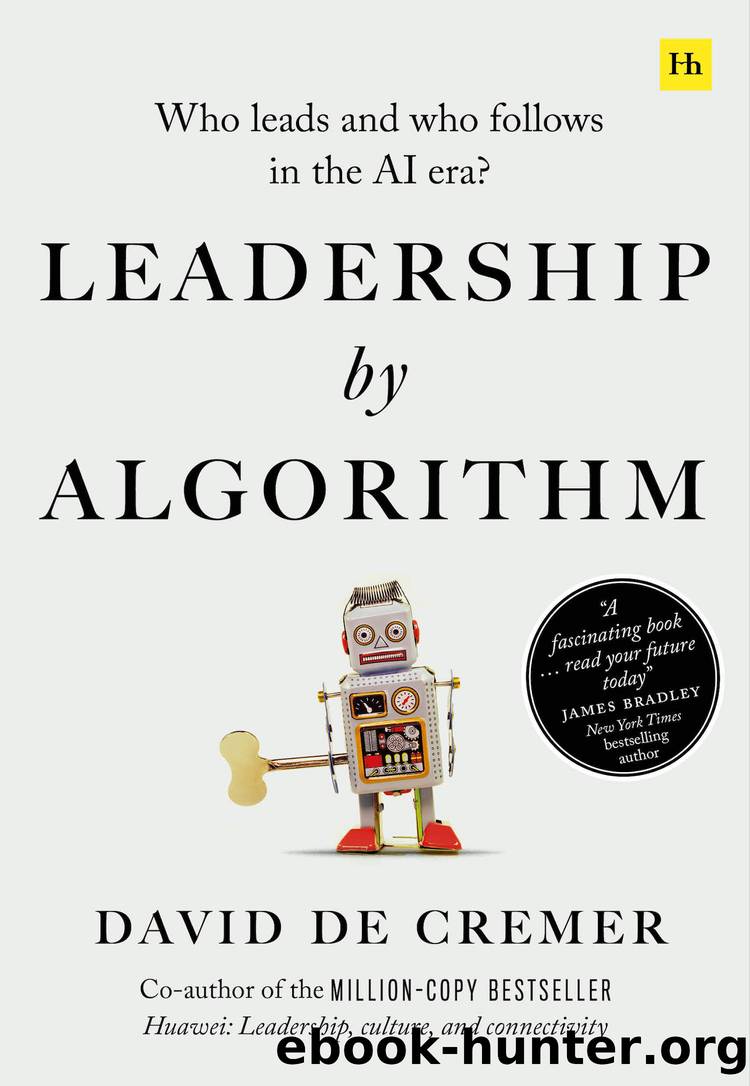Leadership by Algorithm: Who Leads and Who Follows in the AI Era by David De Cremer

Author:David De Cremer [Cremer, David De]
Language: eng
Format: epub
Tags: Business & Economics, General, Computers, Intelligence (AI) & Semantics
ISBN: 9780857198297
Google: gcTgDwAAQBAJ
Publisher: HarrimanHouse
Published: 2020-05-26T20:23:31+00:00
Creativity
Can you be creative without imagination? Not really. For most of us, imagining different realities is a fun activity. When we experience stress, we often retreat to our own imaginary worlds and think about alternate realities that make us happy. Humans have this unique ability to entertain themselves in the world we call imagination. This ability, which distinguishes us from algorithms, is very important when it comes to creativity. As Einstein once said, âcreativity is intelligence having funâ, and all of us understand immediately what he meant by this quote. Algorithms cannot be creative because they work with pattern recognition and curve fitting, which does not allow for the exploration of a reality that does not exist. It thus seems unlikely that algorithms have the same ability as humans to solve creative problems.
Creativity is a process that requires imagination. As creativity involves coming up with new ideas and solutions, imagination is required to, first of all, develop different ways of looking at reality. In those different perspectives, we try to identify opportunities that can generate novel solutions to problems. Creativity is therefore regarded as a key enabler of tremendous advances in organizational productivity and economic growth.127 However, creativity does not only produce novel solutions, but also ones that are useful, which is vital for organizations in the context of a fast-paced business environment.128 The fact that creative solutions also need to be useful is important to stress in light of the human ability to make sense of things.
Creative solutions are meant to solve problems that hinder the pursuit of our goals and achieve results that we consider appropriate in light of our purpose. Because creative solutions are so closely aligned with the value that we want to create as humans, the aha moment that precedes the creative idea is felt physically, emotionally, and mentally. Creativity in itself is such a deep and authentic experience that the process does not function within a controlled and structured operational mode. Algorithms â in their effort to model the human brain â function on a set of well-defined calculative principles. Their way of working is modelled after insights from the field of computationalism, which simplifies the workings of the human brain and associated thinking process to some arbitrary act.129 This kind of algorithmic formalism does not leave room for chaos and, as such, does not allow for any expression of the human experience of creativity.
Does this mean that algorithms cannot provide any input to the process of creativity? Not at all. If we look at scientific literature, we see that creativity can be reached via two paths: flexibility and persistence.130 Flexibility is associated with an open mindset that helps people to adopt different perspectives; avoid being pinned down in looking at reality in a fixed stereotypical way; and connect unrelated concepts and ideas. Persistence is more structured and includes diligent work, systematic thinking and exploration, and knowledge-building in an incremental linear manner.
Looking at these processes shows some parallels between what humans and algorithms can do.
Download
This site does not store any files on its server. We only index and link to content provided by other sites. Please contact the content providers to delete copyright contents if any and email us, we'll remove relevant links or contents immediately.
| Computer Vision & Pattern Recognition | Expert Systems |
| Intelligence & Semantics | Machine Theory |
| Natural Language Processing | Neural Networks |
Algorithms of the Intelligent Web by Haralambos Marmanis;Dmitry Babenko(16223)
Jquery UI in Action : Master the concepts Of Jquery UI: A Step By Step Approach by ANMOL GOYAL(9383)
Test-Driven Development with Java by Alan Mellor(7729)
Data Augmentation with Python by Duc Haba(7605)
Principles of Data Fabric by Sonia Mezzetta(7375)
Learn Blender Simulations the Right Way by Stephen Pearson(7293)
Microservices with Spring Boot 3 and Spring Cloud by Magnus Larsson(7137)
Hadoop in Practice by Alex Holmes(6585)
RPA Solution Architect's Handbook by Sachin Sahgal(6513)
The Infinite Retina by Robert Scoble Irena Cronin(6215)
Big Data Analysis with Python by Ivan Marin(5930)
Life 3.0: Being Human in the Age of Artificial Intelligence by Tegmark Max(5506)
Pretrain Vision and Large Language Models in Python by Emily Webber(4892)
Infrastructure as Code for Beginners by Russ McKendrick(4651)
Functional Programming in JavaScript by Mantyla Dan(4432)
WordPress Plugin Development Cookbook by Yannick Lefebvre(4379)
The Age of Surveillance Capitalism by Shoshana Zuboff(4240)
Embracing Microservices Design by Ovais Mehboob Ahmed Khan Nabil Siddiqui and Timothy Oleson(4146)
Applied Machine Learning for Healthcare and Life Sciences Using AWS by Ujjwal Ratan(4132)
